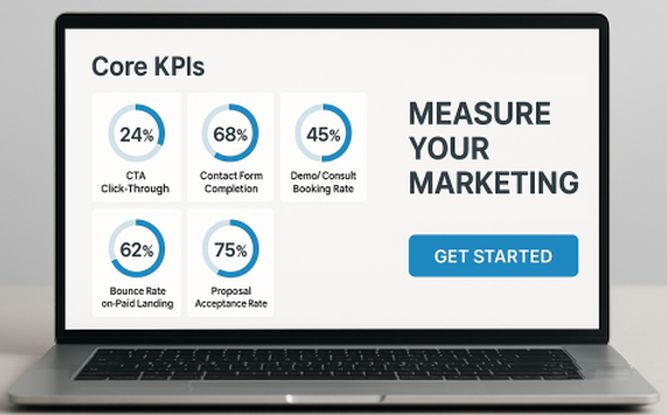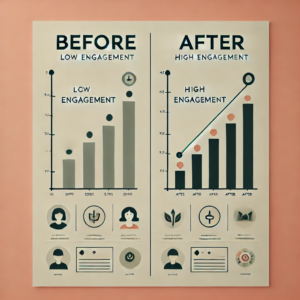5 Brand Voice Errors That Cost Customers: A Decision-Maker’s Playbook
If you sing that tagline that looks “pitch perfect” on paper in the wrong key, your brand voice will strike some sour notes.
That happens when:
- You copy a competitor’s writing style
- Too many writers spoil the broth
- You use AI-generated copy “as-is”
- You write like you think you should sound
Any person or AI can write content that passes spelling and grammar checks. But does it make sense? Are the chords you’re striking resonating with your audience?
If not, your writing voice might be missing a vital ingredient — authenticity — language your readers understand that sounds like you. That humanity — or lack thereof — can decide if your content marketing lives or dies.
Because your brand voice communicates your business’s unique tone and personality — it’s what makes you stand out.
Here’s how to breathe life into dull copy through writing in your own brand voice.
How to Write in Your Brand Voice to Stop Losing Authority to AI Noise
1. Failure: Messaging Derails at Scale
What it looks like: Different teams drafted proposals, web pages, and emails that sound exactly like they were written — by different people.
Why it costs money: Mixed messages erode credibility and can lower sales and response rates.
Before → After:

Before: “We know payroll.”
After: “We cut payroll errors by 80 percent.”
Fix:
- Make a one-page brand voice cheatsheet that pinpoints a client outcome you deliver.
- Audit your content to spot message drift and fix top offenders.
Stats to track: response rate, conversion rate, sales cycle length.
2. Failure: Tone Mismatch
What it looks like: Copy sounds casual when buyers expect authority — or formal when buyers want warmth.
Why it costs money: A misaligned brand voice increases buyer friction; prospects bail because they don’t trust you.
Before → After:
Before: “We’re here to help and make stuff easy.”
After (for corporate buyers): “We reduce vendor risk with documented processes and a 30-day onboarding plan.”
Fix: Map 1–2 buyer personas → select a primary tone → spot the drift.
Stats to track: bounce rates and time on page by persona landing page.
3. Failure: Flunking the “Trust Test”
What it looks like: Grammatically correct content that lacks depth and details. It reads like it was generated, not genuine.
Why it costs money: Visitors can distrust robotic writing. Even if it ranks in search, it can fail to convert. Prospects bounce or second-guess credibility, especially in trust-based industries like finance, law, and consulting.
Before → After:
Before: “We help businesses achieve growth through innovative, client-focused solutions.”
After: “When your inbox overflows and revenue stalls, we help you spot what’s slowing growth — and fix it fast.”
Fix: Check for humanity — have a real reader mark any line that could have come from anyone.
The three-minute gut check:
- Could this sentence appear on a competitor’s site? If yes, make it personal (a client example or a unique process).
- Would you ever say it aloud?
- Does it reveal anything about your team or clients?
Add specifics: proof points, brand wording, and emotional cues (verbs, metaphors, sensory phrasing).
If it suits your brand voice, show some personality. “Being yourself” makes your writing lively and engaging — that includes aiming for a laugh now and then. Humor is sometimes tricky and subjective, but if you handle it well, it comes across well.
Don’t strain to sound like how you think you should sound. Otherwise, your writing might become stiff and formal, lapsing into the passive voice and businessese. Don’t catch those conditions.
Stats to track: Engagement: dwell time, scroll depth, and CTA clicks.
- Scroll depth (aim: +20%)
- Time on page (aim: +15%)
- Conversion on content downloads or consultations (aim: +10–30%)
AI can mimic form, but authentic explanations and storytelling in a human voice can outperform hype or cookie-cutter copy.
4. Failure: Jargon and Feature-First Content
What it looks like: Long lists of features, certifications, or acronyms — little about outcomes: proclaiming, rather than explaining.
Why it costs money: Buyers can’t see the result or return on investment (ROI), so they shop on price or delay the decision.
Before → After:
- Before: “Certified X, API-integrated, SOC2 compliant.”
- After: “Cut invoice processing time in half and free up staffing hours every week.”

Fix: Convert every feature bullet to an outcome sentence using the FAB formula: Features → Advantages → Benefits.
Stats to track: demo requests, time to first meaningful interaction, average deal size.
Example: Clarity and genuine tone outperform inflated marketing claims. MECLABS frames this as a scientific principle: messages that match the way teams naturally explain their value are more credible and convert at higher rates.
5. Failure: Weak or Missing Next Steps
What it looks like: Copy that doesn’t offer benefits or asks only to “Contact us.”
Why it costs money: Prospects who could click stop right there.
Before → After:
Before: “Contact us to learn more.”
After: “Book a free 15-minute voice audit and get one paragraph rewritten with notes for improvement.”
Fix: Add specific, low-risk calls-to-action (audit, sample rewrite, price ranges).
Stats to track: CTA click-through rate and audit-to-project conversion.
Writing in Your Own Brand Voice FAQs
If you doubt your abilities, hiring a pro (like me) can relieve the burden.
Hire a pro when:
▪️ You’re losing leads or conversions
▪️ You lack time for testing
▪️ You need a consistent voice across your content
If it’s a one-off page and you can do A/B testing, you can do it yourself. When in doubt, run the three-minute gut check first.
Core KPIs:
▪️ CTA click-through rate (headline → contact)
▪️ Contact form completion rate
▪️ Demo/consult booking rate
▪️ Bounce rate on paid landing pages
▪️ Proposal acceptance rate
What to fix first (biggest ROI, in order):
▪️ Homepage/Hero: The first impression; it affects many visitors and paid traffic. Measure: CTA click-through rate; contact form conversions.
▪️ Pricing/Services Page: Clears buyer friction and pre-qualifies leads. Measure: demo requests, time on page, bounce on pricing.
▪️ Primary Landing Pages (from ads or top-performing blogs): high intent; minor changes can multiply paid ROI. Measure: conversion rate, cost per lead.
▪️ Key Service Pages/Case Studies: These show proof and outcomes and help close. Measure: proposal requests and acceptance rates.
▪️ Sales/Proposal Templates & Email Sequences: Converts interested prospects into booked calls. Measure: reply rate, demo show rate.
How to choose between pages: score each page 1–5 on Impact (revenue upside) × Traffic (visitors) × Ease (time to implement); prioritize the highest total score.
▪️ Your conversions drop
▪️ Your tone or messaging is inconsistent
▪️ Your message no longer fits your brand direction
Get a rewrite-readiness score with a free content audit.
A strong rewrite package ties scope to measurable outcomes.
▪️ Typical deliverables: a short audit of the existing page, 1–2 draft versions of the rewrite, on-request light SEO alignment (headlines, meta), and 1–2 rounds of revisions.
▪️ Process and timing: audit (1–3 days), first draft (3–7 business days), final delivery after revisions (depending on scope).
▪️ Measurable results to expect and test: headline → CTA click-through rate, contact form completion rate, demo/bookings, and bounce on paid landing pages.
When you sound less like AI and more like a person, the results will become clearer in more click-throughs or responses.
If you’re not used to showing up as yourself on the page, your first attempts can be rough. And if you haven’t thought through who your business is (or wants to be), you might not always know what your brand voice is — or how to write in it to get results.
That’s why following a guide or having someone there to show you can help your wording land with the right clients — those who will value you and your work.
Find out where to improve your brand voice.
What has helped you write in your own voice? Leave a comment.
QUOTES
“If you are not afraid of the voices inside you, you will not fear the critics outside you.” ~ Natalie Goldberg
“When you find your authentic voice, it’s like stepping into a comfortable pair of shoes. The rhythm and pacing of your words feel right, as if they’re meant just for you.” ~ Shirley Kawa-Jump





